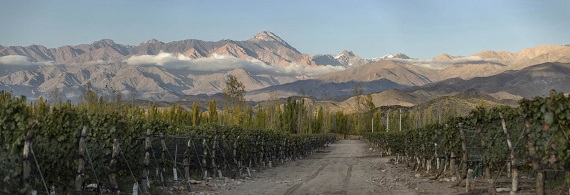Mendoza-born José Alberto Zuccardi, director of Familia Zuccardi, is speaking with Canopy after his family’s wine estate in the Uco Valley was crowned World’s Best Vineyard 2019. It’s a new list of the Top 50 wine estates, created by the owners of the International Wine Challenge and Canopy, to boost international wine tourism.
The inaugural list was announced in London last week and José flew from Argentina especially for the event. On receiving the award, José exclaimed: “It’s a great honour, not just for us but for Argentina, for South America.”
'We put a lot of passion in what we do'The following day, at a restaurant near London’s iconic Tower Bridge, José told Canopy: “We have been working in tourism for many years and our objective is to create an experience for the people – an experience that connects the terroir, our culture, our food. The wine is like a connection between all of them, and when people are having a good experience in the vineyard and a good experience at the winery and have a good experience with a meal and the amazing view, we love it. We put a lot of passion in what we do and it’s fantastic when we have the opportunity to share it.”
When this passion is added to an architectural gem of a winery complex, stunning views of the Andes Mountains, a top-class restaurant focusing on local ingredients, and high-altitude, terroir-driven wines, it’s easy to see why Zuccardi was the clear winner in this new competition.

Three generations of the Zuccardi family are involved in the business. José’s 93-year old mother, Emma, runs the art room, which promotes local painters and sculptors to visitors. She’s also worked with her granddaughter, Julia, to publish a family recipe book, Emma’s Kitchen, which will be sold in the wine shop. “Yes, she still works, there’s no retirement system in our company,” José jokes. “We’ve always said that to work for us is more than a business, it’s a way to live.”
‘Everybody has to follow their own passion’His three children run different parts of the business. “I never pushed them (into the business), I always told them I would be very happy to work with them, but I believe everybody has to follow their own passion,” José said. “They all started new projects in the company. They’re all doing things that I didn’t do before – they restarted the company.”
Daughter Julia runs the hospitality side, which includes two restaurants at the family’s Santa Julia winery in Maipú and one at the new winery in the Uco Valley.
Miguel makes amazing olive oils from more than 100 different varieties spread over 85ha in Maipo.

Sebastián (pictured with José above) is the winemaker and the one who started the project in the Uco Valley after spending seven years working vintages in the Northern Hemisphere as well as at the family’s original vineyard and winery, 40 minutes from the centre of Mendoza City.
José realises he is lucky that his children all wanted to go down slightly different routes and that he gets to work with all of them. “I try to become part of their projects because I love to work with them,” he confirmed.
All, however, are guided by the company’s four long-term objectives:
- To increase the quality “all the time in everything we do”;
- To innovate – “We think that in wine, olive oil and hospitality you should not just follow the traditions”;
- Be kind to the environment – “We want that the people who come after us can do at least what we are doing”;
- Be useful to the local society – “Wine is place and people. We need good people, so we invest a lot in education in the region”.

The winemaking
Winemaker Sebastián’s chief aim is to express the terroir. “He always says he wants to do wines that talk about the place, about the vineyard – to keep in the winery what is coming from the vineyard,” said the proud father.This means organic grapes, native yeasts, large amphora-shaped cement tanks, used French oak barrels (225L and 500L), and the use of gravity where possible to move the juice, must and wine.
To increase the quality and their understanding of the wines, there are at least four agronomists/oenologists working in the winery’s research laboratory, studying the diversity of the valley’s soils and mapping the subsoils, as well as analysing the wines.
The tour
Tours start in the vineyards surrounding the winery. Visitors are shown two soil pits about 5 metres apart. One has very little topsoil and the other has plenty.“We show them how we classify the soils in the vineyards and why we vinify them separately,” José said. Sometimes the harvest dates of plots with different soil profiles are 15 days apart.
From the vineyard, visitors are guided into the beautiful but very functional winery.
“When you go into the winery it is like you go into the mountains. You see some water, you see the stones, the gardens are natural vegetation,” José said. “When we designed the winery we had two conditions: to make the vinification process as simple and as environmentally friendly as possible and to be part of the place.”
Bodega Zuccardi Valle de Uco opened in March 2016, after three years of construction. The money for the project came from the family or, as Sebastián said at the opening, “This winery is made with wine.”
It is constructed from locally sourced materials – rocks from Zuccardis’ Piedra Infinita vineyard, and water and sand from the Tunuyan River. Inside, natural light filters through slatted windows giving enough luminosity for the winemakers to work, but not enough to affect the wines.
The winery is set over three levels: the offices, grape reception area and tank openings are on the first floor; the production area and research lab are on the ground floor; while the basement holds the cement tanks, 3,000-litre foudres and used barrels.

A metal dome crowning the building acts as a mirror to the sky, reflecting the different colours of each hour of the day. Under the dome is one of the two tasting rooms. The other is next to the barrel room.


Most tours conclude in the restaurant, the Piedra Infinita Cocina, which offers a refined four-course seasonal and regional menu alongside breath-taking views of the Andes range. It’s right to admire the mountains while tasting the local food and wines because it’s the mountains that make the wine what it is. They hold back the rain coming from the Pacific, making the region a desert. They also provide the water for the irrigation system but, most importantly, José said: “They give us our altitude.” That means cooler temperatures and increased sunlight.
It all began with irrigation

Immigrants from Italy, the Zuccardi family has been in Mendoza since the late 19th century. During the 1950s, José’s father, Don Alberto, started his own irrigation company, specialising in irrigation techniques for the grape and soft fruit industries. In 1963, as a way of demonstrating the effectiveness of his modified irrigation systems, Don Alberto purchased the site of what is now the family’s Maipu vineyard, administrative offices and the main winery.
So confident in his irrigation system was Don Alberto that in 1973 he purchased a second vineyard site in the desert area of Santa Rosa: 1,400ha of dry scrub-land, of which 410ha are now under vine.
José started working with his father in 1976 and soon expressed an interest in taking over the vineyards. He started producing simple wines that were sold in bulk, and progressed to bottling his own wines in 1981, travelling from town to town to sell them and find distributors. In 1985, he took over the running of the whole company.
'We enjoy our activities'A visit to Vinexpo in Bordeaux in 1991 opened his eyes to the potential of the business. “I never thought that there was such a world behind the wine,” he told Canopy. Soon afterwards, he started to export his wines and began to turn the business into Argentina’s largest family-owned winery, collecting the IWC Lifetime Achievement Award along the way.
“It's good because I still enjoy what I do, that’s the most important thing,” he said. “The only thing that justifies to wake up is to do something you enjoy. We are not a company paying attention to just putting money in our pockets. If we have money, we invest it. We enjoy our activities.”

World’s Best Vineyard
Zuccardi Valle de Uco was voted the World’s Best Vineyard by an international ‘academy’ made up of nearly 500 leading wine aficionados, sommeliers, and luxury travel experts.The top ten saw a particularly strong showing from South America: two wineries from Argentina, two from Chile and one from Uruguay. For the full Top 50, click here.
Canopy asked José why South America shone. He replied: “The wineries in South America are paying a lot of attention to the tourism because it’s a very good way that people remember in the long-term. Maybe also because tourism is growing in South America.”
Future plans
José selects a glass of Viognier from the Languedoc, as our quick coffee turns into a long lunch. José planted Argentina’s first Viognier vines in 1993, and the country’s first Zinfandel in 1997. Innovation has been important for Zuccardi from the beginning.Desert vineyards, a modified parral system, and new types of irrigation, hail control and frost avoidance are all part of his legacy.
What’s next, I wonder?
“We always have more plans than money and time,” was his reply.
He then reveals that they are currently experimenting with 20,000 litres of ‘natural’ wine – a sulphite-free organic Malbec made in concrete tanks. They want to see how it ages before putting it on the market, but he admits: “We are now designing the label. We have to try and we have to learn, to understand what will be the life of the wine.”
They hope to release the wine later this year in the local market. “We want to be close to see the evolution and to work with specific customers to learn,” he advised.
As we finish our Viogniers, I congratulate José again on his award.
“We don’t work for recognitions but when the recognitions come it makes us very happy. It’s an indication we’re going in the right direction. And it gives us more energy to do more things.”













.png)






